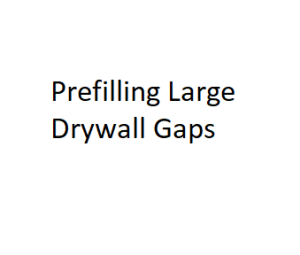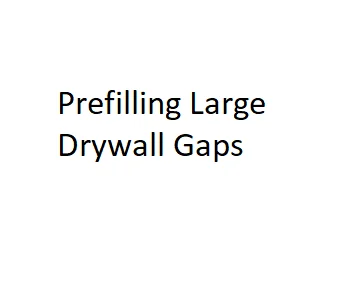When it comes to drywall installation, achieving a seamless and polished finish is essential for a professional look. However, encountering large gaps between drywall sheets is not uncommon, and addressing them properly is crucial. In this guide, we’ll explore the process of prefilling large drywall gaps to ensure a smooth and flawless final result.
Identifying the Issue:
Before diving into the prefilling process, it’s essential to identify the cause of the large gaps. Uneven framing, settling of the building, or even human error during installation can lead to gaps that need attention. Once you’ve pinpointed the issue, you can proceed with the prefilling steps.
Materials and Tools:
To prefill large drywall gaps, you’ll need the following materials and tools:
- Drywall joint compound: Choose a high-quality joint compound that is easy to work with and sands smoothly.
- Drywall tape: Reinforce the gaps with drywall tape to prevent future cracks.
- Putty knife or taping knife: For applying joint compound and smoothing the surface.
- Sanding block or sandpaper: To achieve a smooth and even finish.
Prefilling Process:
- Clean the Gap: Before applying any joint compound, make sure the gap is clean and free of dust or debris. Use a vacuum or a damp cloth to remove any loose particles.
- Apply Drywall Tape: Place drywall tape over the gap to provide additional support and prevent future cracking. Press the tape firmly into the gap, ensuring it adheres well to both sides.
- First Layer of Joint Compound: Using a putty knife or taping knife, apply a thin layer of joint compound over the taped gap. Make sure to feather the edges to blend with the surrounding drywall. Allow this layer to dry completely.
- Second Layer of Joint Compound: Once the first layer is dry, apply a second layer of joint compound. This layer should be slightly wider than the first to further blend the gap into the surrounding surface. Again, allow it to dry thoroughly.
- Sand and Smooth: After the second layer has dried, use a sanding block or sandpaper to smooth the surface. Pay attention to achieving a seamless transition between the patched area and the existing drywall.
- Final Touches: Inspect the prefilled gap for any imperfections. If needed, apply an additional layer of joint compound and repeat the sanding process until you achieve a flawless finish.
Dealing with Common Challenges:
- Shrinking of Joint Compound: Sometimes, joint compound can shrink as it dries, leaving behind small gaps or cracks. To address this, apply an additional layer of joint compound and make sure each layer is allowed to dry thoroughly before applying the next.
- Multiple Applications: Depending on the size of the gap, you may need to apply more than two layers of joint compound. Be patient and take the time to build up the layers gradually, ensuring each layer is properly dried and sanded before adding the next.
- Choosing the Right Joint Compound: There are different types of joint compounds available, including lightweight and heavyweight options. Choose the compound that best suits your project, considering factors like ease of sanding and drying time.
Tips for a Professional Finish:
- Feathering Edges: Feathering the edges of the joint compound is crucial for a seamless finish. Gradually taper the compound towards the edges to blend it with the existing drywall, avoiding noticeable transitions.
- Sand in Stages: Sanding is a critical step in achieving a smooth surface. Start with coarse sandpaper to level the compound and then move to finer grits for a polished finish. Sand in stages, checking the progress regularly.
- Priming Before Painting: Once the prefilling process is complete and the surface is smooth, consider applying a primer before painting. Primer helps the paint adhere better and provides a more even finish.
- Professional Help: If you find yourself dealing with extensive drywall issues or if the gaps are beyond your comfort level to fix, consider seeking professional assistance. Experienced contractors have the skills and knowledge to handle challenging drywall problems efficiently.
Beyond Prefilling: Preventative Measures and Additional Considerations:
- Addressing Structural Issues: While prefilling is effective for cosmetic improvements, it’s essential to address any underlying structural issues that may be causing the gaps. Consult with a professional if you suspect problems with the framing or settling of the building.
- Expansion Joints: In areas prone to temperature and humidity fluctuations, consider installing expansion joints. These joints allow for natural expansion and contraction, reducing the likelihood of future cracks or gaps in the drywall.
- Regular Maintenance: Keep an eye on your walls over time. Conduct regular inspections to identify any new gaps or cracks that may have developed. Addressing issues promptly can prevent them from escalating into more significant problems.
- Choosing the Right Drywall Type: Different types of drywall have varying degrees of flexibility and resistance to cracking. Consider using flexible drywall or a combination of standard and flexible boards in areas prone to movement or settling.
- Expert Consultation: If you’re uncertain about the best approach to prefilling or dealing with drywall gaps, consult with a professional contractor or drywall expert. They can provide valuable insights, recommend appropriate materials, and ensure that the job is done to industry standards.
DIY Success Stories:
- Online Tutorials and Communities: Take advantage of online tutorials and DIY communities where experienced individuals share their drywall prefilling experiences. You may find valuable tips, troubleshooting advice, and encouragement from those who have faced similar challenges.
- Learning from Mistakes: Don’t be discouraged by setbacks. Learning from any mistakes you make during the prefilling process can contribute to your growth as a DIY enthusiast. Each project is an opportunity to refine your skills and knowledge.
Common Materials for Prefilling Large Drywall Gaps
| Material Type | Description | Advantages | Disadvantages | Recommended Usage |
|---|---|---|---|---|
| Joint Compound | Lightweight, easy to apply | Smoothes gaps effectively | Longer drying time | Small to medium-sized gaps |
| Setting Type | Quick setting, minimal shrinkage | Fast drying time | Limited working time | Large gaps |
| Expanding Foam | Fills gaps completely | Expands to fill voids | Messy application | Large irregular gaps |
| Mesh Tape | Reinforces joints and gaps | Prevents cracks | Requires multiple layers | Gaps with potential movement |
| Wood Shims | Sturdy support for large gaps | Provides structural support | May require trimming | Large gaps with framing issues |
Tools for Prefilling Large Drywall Gaps
| Tool Name | Description | Advantages | Disadvantages | Recommended Usage |
|---|---|---|---|---|
| Putty Knife | Spreads joint compound smoothly | Affordable and easy to use | Limited for larger gaps | Small to medium-sized gaps |
| Drywall Saw | Cuts openings for large gaps | Precise cutting | Generates dust | Large gaps with framing issues |
| Trowel | Applies and smoothes compound | Larger surface area coverage | Requires skill for even finish | Medium to large-sized gaps |
| Foam Gun | Precise application of expanding foam | Controls foam dispensing | Cleaning can be cumbersome | Large irregular gaps |
| Mesh Tape Roller | Ensures even application of mesh tape | Speeds up taping process | Limited to taping | Gaps with potential movement |
| Jab Saw | Makes quick cuts in drywall | Compact and portable | Limited for fine cuts | Medium to large-sized gaps |
Drying Times for Different Prefilling Materials
| Material Type | Drying Time | Sanding Time | Paint Ready | Recommended Usage |
|---|---|---|---|---|
| Joint Compound | 24-48 hours | 24 hours | Yes | Small to medium-sized gaps |
| Setting Type | 5-90 minutes | 30 minutes | Yes | Quick fixes, large gaps |
| Expanding Foam | 1-8 hours | 24 hours | Yes | Large irregular gaps |
| Mesh Tape | Dependent on compound drying time | After compound is dry | Yes | Gaps with potential movement |
| Wood Shims | N/A (Dependent on joint compound) | N/A (Dependent on joint compound) | Yes (After joint compound dries) | Large gaps with framing issues |
Tips for Effective Prefilling of Large Drywall Gaps
| Tip Number | Tip Description |
|---|---|
| 1 | Clean gaps thoroughly before applying any material |
| 2 | Use a backer rod for deeper and irregular gaps |
| 3 | Apply joint compound in thin layers for better adhesion |
| 4 | Allow each layer to dry completely before reapplying |
| 5 | Sand surfaces between layers for a smooth finish |
| 6 | Choose the right material based on gap size and type |
| 7 | Test-fit drywall pieces before applying permanent fix |
| 8 | Wear appropriate protective gear, especially for foam |
| 9 | Ensure proper ventilation when working with compounds |
| 10 | Follow manufacturer’s instructions for each material |
Common Mistakes to Avoid During Prefilling Process
| Mistake Number | Mistake Description |
|---|---|
| 1 | Neglecting to clean gaps before application |
| 2 | Overlooking the need for structural support |
| 3 | Applying too much compound in a single layer |
| 4 | Ignoring drying times and rushing the process |
| 5 | Using the wrong material for the specific gap type |
| 6 | Neglecting to wear protective gear, especially for foam |
| 7 | Failing to test-fit drywall pieces before final fix |
| 8 | Inadequate sanding between compound layers |
| 9 | Not addressing the root cause of the gap (e.g., framing issues) |
| 10 | Applying paint before the prefilled area is fully dry |
Conclusion:
Prefilling large drywall gaps is a crucial step in achieving a flawless finish, but it’s not just about fixing the visible issues. Taking a holistic approach, addressing potential causes, and incorporating preventative measures will contribute to the long-term integrity of your walls.
Remember that every DIY project comes with its challenges, and patience is your greatest ally. Embrace the learning process, seek guidance when needed, and take pride in the transformation you bring to your living spaces. With the right tools, techniques, and mindset, you can turn any drywall challenge into a satisfying accomplishment. Happy renovating!
